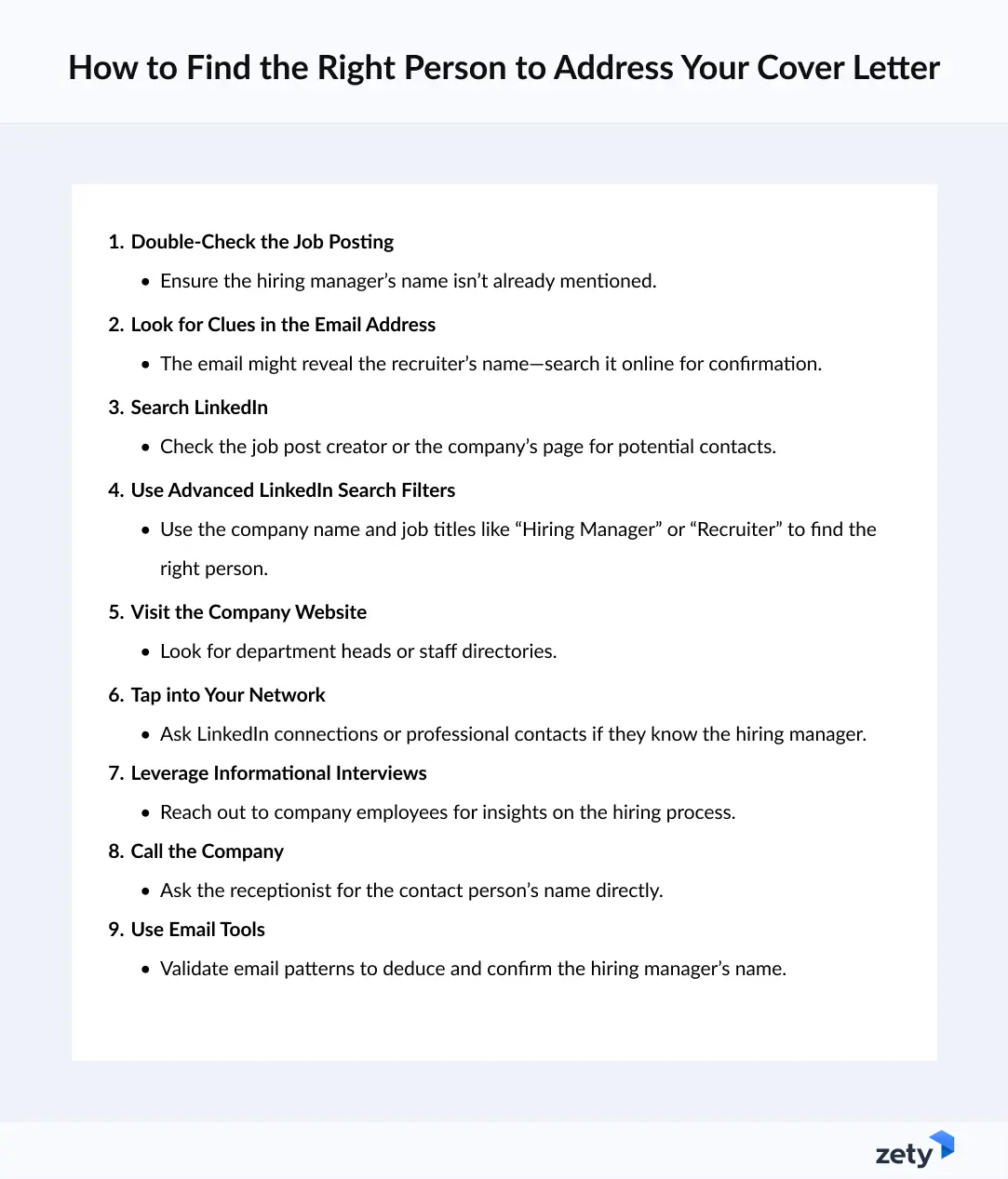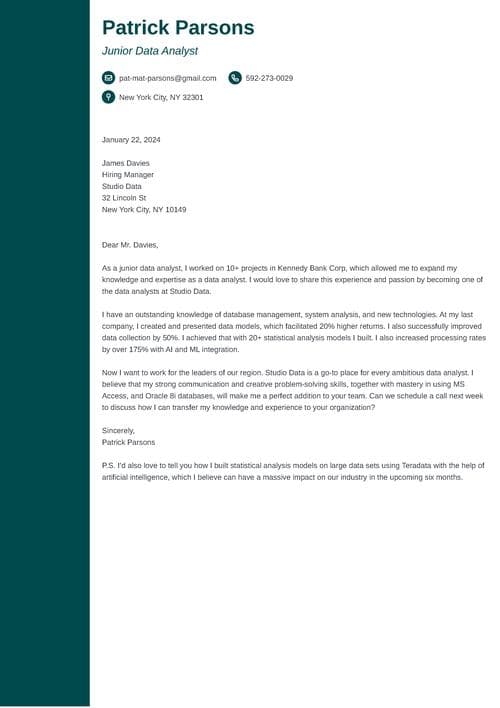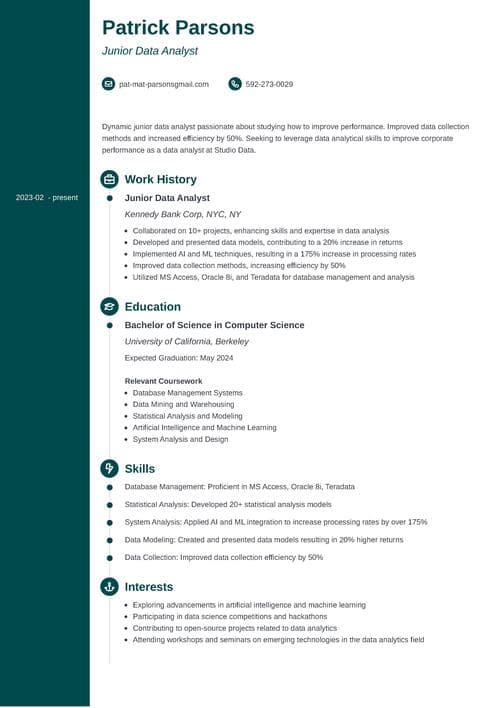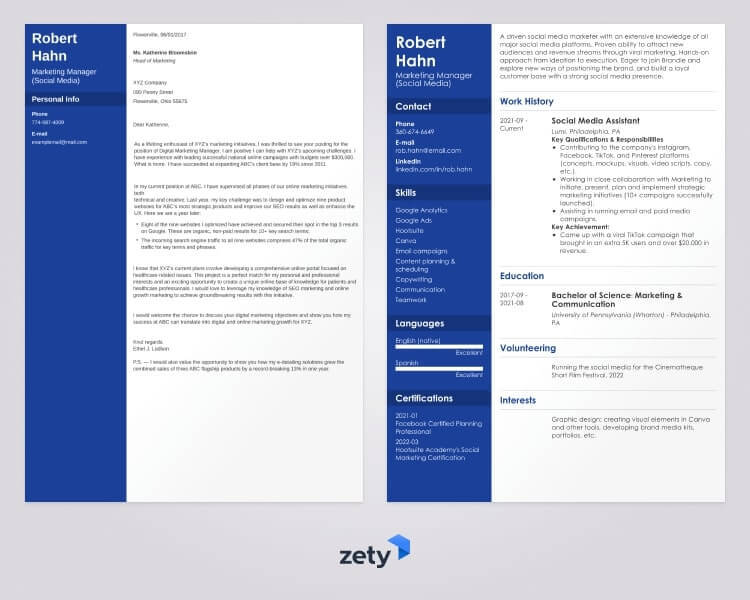The first line of your cover letter can make the recruiter squirm and reject your application, or encourage reading further. Don’t risk it!
Learn how to address a cover letter the right way. I will teach you who to address a cover letter to and even how to address a cover letter without a name. Let's begin!
This guide will show you:
- How to address a cover letter correctly when you know the recruiter’s name.
- Ideas on how to address a cover letter without a name.
- Who to address a cover letter to, especially if the recipient is unknown.
- Common cover letter addressing mistakes.
Want to write your cover letter fast? Use our cover letter builder. Choose from 20+ professional cover letter templates that match your resume. See actionable examples and get expert tips along the way.
Sample cover letter for a resume—See more cover letter examples and create your cover letter here.
Before you dive deeper, look at the video created by our career expert Caio on how to address a cover letter:
Enough chitchat—let’s learn how to address a hiring manager in a cover letter:
How to Address a Cover Letter With a Name
People love the sound of their names. Studies show that babies as young as five months old already react to hearing their names. Using a person’s name in direct communication helps to establish a connection, so it’s no wonder you should use it in the cover letter address. Here’s how to do it correctly:
- Start with Dear + recipient’s first name or their first and last name.
- Use honorific titles such as Mr. or Ms. only if you’re 100% certain of the recipient’s gender identity.
- Add titles such as Mrs. or Miss only if you know for certain that the recipient prefers them.
Just like that:
Cover Letter Address: Examples With Recipient’s Name
| RIGHT |
|---|
|
See? It’s super straightforward.
Read more: How to Write a Compelling Cover Letter Introduction
Using a Professional Title in the Cover Letter Address
If the recruiter has a specific title, such as Professor or Doctor, it is respectful to use them in your cover letter salutation. This shows professionalism and courtesy, traits that most recruiters expect to see in cover letters. See these examples:
Cover Letter Address Examples With Professional Titles
| RIGHT |
|---|
|
Finding Who to Address a Cover Letter To
It’s true that many job postings don’t include the recruiter’s or hiring manager’s name, leaving you wondering, "Who should I address my cover letter to?" But don’t despair—just channel your inner Sherlock Holmes and investigate using the tips below!
Here are a few ideas to help you establish the right cover letter address:
- Carefully scan the job posting: make sure the hiring manager’s name's not in it—maybe you missed it on the first try?
- Analyze the email address in the job posting: an email like alliefenestra@company.co most likely includes the recruiter’s name. Give it a Google search and see if a person’s profile comes up.
- Check LinkedIn: job offers posted on LinkedIn often indicate the person who created the offer. You can also take a look at the company’s LinkedIn page to see if the hiring manager is mentioned.
- Use advanced LinkedIn searches: On LinkedIn, you can also filter your search by company name and department or job title (e.g., “Hiring Manager,” “HR Manager,” or “Recruiter”) to find the right contact.
- Check the company website: see if it lists the department’s heads.
- Ask your business network: there’s a chance your LinkedIn connections know someone working for the company that interests you!
- Ask during informational interviews: If you’ve networked with someone in the company and established a good rapport, ask if they know who’s responsible for hiring.
- Call the company:surprise, surprise—you can actually call the front desk and ask the receptionist for the name of the contact person.
- Use email validation tools: Tools like Xrilion.com can help validate email patterns within a company. If you guess a name and email pattern (e.g., firstname.lastname@company.co), it can confirm if it's likely correct.

Read more: 81% of Recruiters Have Rejected Someone Based on Details in their Cover Letter
How to Address a Cover Letter Without a Name
If you still can’t find a specific person to address your cover letter to, I’ve got some tried-and-tested cover letter salutations you can use. Check out the tips below on addressing a cover letter without the recipient’s name:
Address a Cover Letter with “Dear Hiring Manager”
It’s the easiest way to address a cover letter without a name. Plus, 40% of managers prefer "Dear Hiring Manager" to any other cover letter salutation. You can also replace the Hiring Manager with a different business title, such as:
| RIGHT |
|---|
|
As you see, this type of cover letter address works in many situations.
Pro Tip: Tailor your salutation and the entire cover letter to match the company’s tone and culture. For example, a formal “Dear Hiring Manager” might work best for a traditional corporate environment, but a more casual greeting like “Hello [Team Name]” could suit a startup or creative company. Always research the company’s communication style to make the best impression.
Avoid Gendered Greetings in Your Cover Letter Address
Steer clear of phrases like "Dear Sir/Madam" or "Dear Mr./Ms." unless you’re confident about the recipient’s title and gender identity. Gender-neutral greetings such as "Dear Hiring Manager" are more inclusive and widely accepted.
Don’t Let the Lack of a Name Hold You Back
Not knowing the hiring manager's name won't disqualify you as long as the rest of your cover letter is compelling. Focus on highlighting your qualifications, enthusiasm, and how well you fit the role.
If you couldn't find the name, make up for it by demonstrating your knowledge of the company and position in the body of your letter. Reference specific details about the company's mission, projects, or values to convey your genuine interest and dedication.
We evaluated 11 million resumes created using our builder and found that these are the top 10 professions that often include a cover letter:
- Business Operation Specialists
- Top Executives
- Advertising, Marketing, and PR Managers
- Clerks
- Engineers
- Retail & Sales Representatives
- Healthcare Practitioners
- Financial Specialists
- Teachers and Instructors
- Counselors, social workers, and social service specialists
4 Cover Letter Address Mistakes to Avoid
Many job applicants fall for common mishaps when addressing a cover letter. If you're still a bit unsure how to address the cover letter’s recipient, let me help you avoid the most common mistakes—familiarize yourself with them to make a great first impression!
1. Starting the Cover Letter Address Informally
| WRONG |
|---|
|
Addressing a cover letter with "Hello" or "Hi" is a tad too informal for many companies.
2. Using Dear Sir or Madam
| WRONG |
|---|
| Dear Sir or Madam, |
Don't use Dear Sir or Madam, even if you’re unsure who to address a cover letter to. It’s a very outdated phrase, and it will make you look lazy.
3. Using To Whom It May Concern
| WRONG |
|---|
| To Whom It May Concern, |
Writing "To Whom It May Concern" in a cover letter salutation is very old-fashioned. Unless you traveled back in time and you’re seeking employment in the 19th century, don’t use it. It shows you haven't done your research and is not welcome when addressing a cover letter.
4. Addressing the Cover Letter to the Wrong Person
| WRONG |
|---|
| Dear Human Resources Director, |
This looks fine at first glance. However, the HR director doesn’t necessarily have to be the hiring manager leading this particular recruitment process. Pay attention to the roles and departments mentioned in the job posting!
Pro Tip: Careful with spelling—if you address a cover letter with a misspelled name, you’ll end up looking pretty silly.
Make sure your knowledge of cover letter rules is up-to-date with these guides:
- How to Write a Cover Letter
- How to Format a Cover Letter
- How to Write a Killer Cover Letter
- Cover Letter Header: What Is It & Examples
- Best Short Cover Letter Examples
- Email Cover Letter Examples
- What Should a Cover Letter Say
- How to Sign a Cover Letter Properly
- What to Include in a Cover Letter
Plus, a great cover letter that matches your resume will give you an advantage over other candidates. You can write it in our cover letter builder here. Here's what it may look like:
See more cover letter templates and start writing.
Key Takeaway
That’s all you need to know on the subject of addressing cover letters. Here are a few important points to remember:
- If you're addressing your cover letter to a specific person, use their name and title. If not, consider addressing the cover letter to "Dear Hiring Manager" or "Dear Human Resources."
- You can always start your cover letter with “Dear Hiring Manager,” but there are some alternatives, like "Dear Human Resources" or "Dear [Team] Manager."
- If you’re unsure who to address a cover letter to, do your best to learn the hiring manager’s name.
- Avoid informal greetings and salutations such as “Dear Sir or Madam” and “To Whom It May Concern.”
Now you know how to address a cover letter correctly!
About Zety’s Editorial Process
This article has been reviewed by our editorial team to make sure it follows Zety's editorial guidelines. We’re committed to sharing our expertise and giving you trustworthy career advice tailored to your needs. High-quality content is what brings over 40 million readers to our site every year. But we don't stop there. Our team conducts original research to understand the job market better, and we pride ourselves on being quoted by top universities and prime media outlets from around the world.



